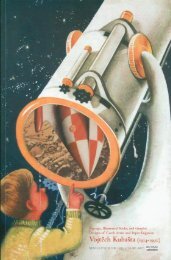NEXT STOP: POP-UPS - The Popuplady
NEXT STOP: POP-UPS - The Popuplady
NEXT STOP: POP-UPS - The Popuplady
Create successful ePaper yourself
Turn your PDF publications into a flip-book with our unique Google optimized e-Paper software.
Chapter<br />
7<br />
Teaching<br />
and Learning<br />
FIGURE 7.1 Student work from Pratt Institute, NY<br />
FIGURE 7.2 Student work from Pratt Institute, NY<br />
M<br />
any colleges and universities offer courses in paper engineering. Pratt Institute<br />
in Brooklyn, New York offers a full semester elective in introductory paper<br />
engineering, a course created by Robert Sabuda and now instructed by Kyle Olmon,<br />
one of Robert Sabuda’s protégés. When asked if he incorporates light and sound in his<br />
syllabus, Olmon responded by saying, “<strong>The</strong> students that participate in my course come<br />
from various disciplines within the university and bring with them very unique and<br />
diverse skill sets. If they have a background in electronics or fiber or another relevant<br />
field I will always encourage them to incorporate their technical know-how as long as it is<br />
appropriate for the design.” 1<br />
At Mills College in Oakland, California, Julie Chen, book artist teaches semester long<br />
classes in bookmaking which includes paper engineering. Undergraduate courses in<br />
book arts and a graduate degree in Creative Writing and Book Arts are offered. <strong>The</strong>re, in<br />
addition, she teaches many workshops nationwide. Because Chen is such a proponent of<br />
movable parts as a means to convey an idea in her artist books, she shares that enthusiasm<br />
with her students.<br />
<strong>The</strong>re are a plethora of workshops that teach paper engineering to enthusiasts young and<br />
old all over the country. In 2010 the Center for Book Arts in New York City offered<br />
workshops in paper engineering, such as Animated Pop-Up Structures, Pop-Up Paper<br />
Engineering Basics and Beyond and Carousel Books. At the National Museum of Women<br />
in Washington, DC there is a year-long arts curriculum called ABC Art Books Creativity,<br />
in which fourth grade students develop visual literacy by creating an artist book. This<br />
course is taught by Carol Barton, who has authored and published instructional books<br />
on paper engineering. “<strong>The</strong> Pocket Paper Engineer Workbook, Volume 1 Basic Pop-Up<br />
Forms” and :Volume 2 Platforms and Props” are valuable teaching tools for anyone that<br />
is beginning to explore paper engineering. Her simple-to-make and understand, stepby-step<br />
projects offer a good foundation from which to spring board ideas. Barton is<br />
working on Volume 3 which she will publish in the near future. She not only conducts<br />
workshops for children and adults, but also for teachers. She feels that instructing<br />
teachers on teaching paper engineering to children “is the most incredible way to teach<br />
several subjects such as trial and error, problem solving, 3D design, movement, mechanics<br />
and building processes.” 2 In 2010, Leah Buechley, Director of MIT’s High-Low Tech<br />
Lab gave a workshop at the Fuller Craft Museum in Brockton, Massachusetts on how to<br />
create electronic paper structures. This is a cutting-edge approach in bridging electronics<br />
technology with paper craft. Buechley’s primary objective is to expose and engage diverse<br />
audiences to new technology through familiar craft processes.<br />
<strong>The</strong>re are software programs that assist in designing pop-ups. One is Pop-Up Workshop.<br />
With this software, a person creates a design for a pop-up card in the computer. After the<br />
design is finished, it can be printed out and physically made. 3 A recently launched website,<br />
ZooBurst.com features a storytelling application that allows practically anyone, novice or<br />
experienced, to author a live digital pop-up book. 4 <strong>The</strong> author can use the library of clip<br />
art provided on the website or one’s original art. <strong>The</strong> creator of this application is Craig<br />
Kapp, a Researcher in Residence at the Interactive Telecommunications Program (ITP) at<br />
NYU. Kapp’s application is to be used in the classroom where teachers help their students<br />
create books as a means to learn the art of storytelling. <strong>The</strong> application was updated in<br />
2010 to include multi-language features, links to outside websites within the talk bubbles<br />
in the book, sound effects and voice recordings.<br />
<strong>The</strong>re is an extensive selection of published books on how to do pop-ups/paper<br />
engineering. David A. Carter with James Diaz wrote “Elements of Pop Up: A Pop-Up<br />
Book for Aspiring Paper Engineers”. Carter was encouraged to write this book because<br />
“everyone says, write what you know.” 5 This book is designed to teach graphic designers<br />
about paper engineering and how they would work inside a book. Some other books<br />
include: “<strong>The</strong> Pop-Up Book” by Paul Jackson, “Pop-Up!: A Manual of Paper Mechanisms”<br />
by D. Birmingham, “3D Pop-Up Greeting Cards” by Keiko Nakazawa, “Cards that<br />
Pop-Up, Flip & Slide” by Michael Jacobs and even a “Paper Engineering & Pop-Ups for<br />
Dummies” by Rob Ives.<br />
FIGURE 7.3<br />
Julie Chen’s workshop at Garage Annex School, MA<br />
FIGURE 7.4<br />
Page from digital pop-up book, Zooburst.com<br />
34 35



